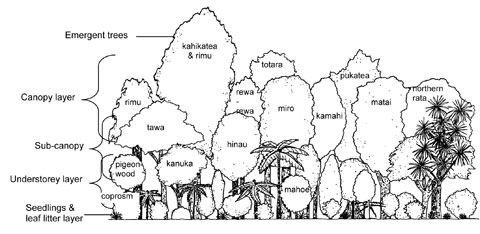Bush layers
Introduction
Healthy bush has a structure of many 'layers', from tiny seedlings on the forest floor up to the tallest trees towering over the forest canopy.Healthy bush has a structure of many ‘layers’, from tiny seedlings on the forest floor up to the tallest trees towering over the forest canopy. The following illustrates the different layers within a hypothetical piece of bush in the Waikato.
Fig 1: cross-section diagram of native bush showing forest layers
(view larger image JPG, 30K)
Healthy bush is characterised by a deep covering of leaves on the ground (leaf litter) which, together with rotting logs and branches, provide ideal growing conditions for a mosaic of ferns, mosses, lichens and emerging seedlings.
Above the forest floor there should be an understory and sub-canopy layer, making it difficult to see far into the bush before there is a ‘wall’ of vegetation.
Understory plants such as coprosmas, kawakawa, mingimingi and tree ferns occupy the layer from a height of approximately 20 cm to 2.5 m. Above this, the taller sub-canopy trees (e.g. mahoe, pate, putaputaweta and pigeonwood) form a layer between the understory and the canopy.
Below the canopy you will also find saplings of various ages waiting to be ‘released’ in the gaps left by older trees as they die.
A healthy canopy will be almost continuous (except for tree-fall gaps) and will usually comprise a variety of species, with different trees dominating over time as they compete for space in the canopy. Common canopy trees in the Waikato are tawa, titoki and pukatea and on hillsides, kohekohe and hinau. When looking up into the canopy you should see climbing vines (such as rata and supplejack) and different species of epiphyte e.g. Astelia and filmy ferns.
The final layer, the ‘emergents’, are particularly tall trees that tower above the surrounding canopy e.g. kahikatea, totara and rimu.

